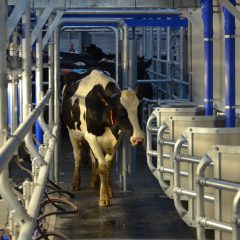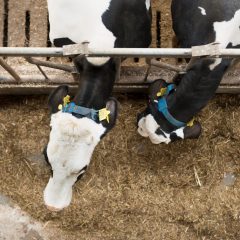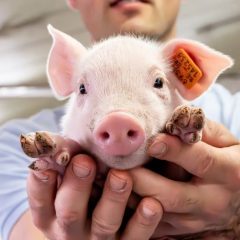Dossier Alternatives to castration of piglets
Castration of piglets has been on the European animal welfare agenda for more than 20 years. As of Jan. 1, 2024, in Belgium this can only be done with local anesthesia and pain control. There are also other alternatives, each with its advantages and disadvantages. What are these alternatives? What is the state of affairs and what steps are needed for further implementation?
What does ILVO do?
-
 Implementation of sensory detection of boar taint and training of experts.
Implementation of sensory detection of boar taint and training of experts. -
 Set up and follow up experiments and evaluate boar taint based on sensory and chemical analysis.
Set up and follow up experiments and evaluate boar taint based on sensory and chemical analysis. -
 Advice and support for both pig farmers and the meat processing chain.
Advice and support for both pig farmers and the meat processing chain. -
 Evaluation of how management adjustments affect profitability.
Evaluation of how management adjustments affect profitability. -
 Based on measurements and taste tests.
Based on measurements and taste tests.
Why castrate male piglets?
About 4% of male pigs or "intact boars" have boar taint. This is an unpleasant odor or taste found in pork and fat. Boar taint is caused by the accumulation of androstenone and skatol in the fatty tissue of male pigs. To a lesser extent, indol is also thought to play a role in this. Androstenone is produced in the testes. Part of it is released through saliva and acts as a pheromone: it stimulates oestrus and staging behavior in the sow. The remainder is stored in fatty tissue. Skatol and indol are formed by bacteria in the large intestine in both female and (castrated) male pigs, but the presence of androstenone in intact boars causes the breakdown in the liver to be inhibited and these components are thus stored in fat.
To avoid this undesirable odor or taste in boars, most male piglets are castrated. As a result, these male pigs are also less aggressive and exhibit less sexual behavior. Even in Europe, this castration is still mostly done without anesthesia, with or without pain relief. Farmers perform this surgical procedure themselves when the piglets are no more than 7 days old.
What are the alternatives?
For over 20 years, the search for alternatives to non-anesthetized piglet castration has been on the agenda both in Belgium and Europe. Both during the procedure and a few days afterwards, castration causes pain and discomfort to the piglet, putting pressure on this practice. To move away from this, the industry has made considerable efforts. This has resulted in several alternatives currently used in Europe, namely:
- castration of piglets using pain relief
- castration of piglets under local or general anesthesia
- no castration: production of intact boars
- no castration: application of vaccine-based immunocastration
In other words, either the piglets are still castrated in a more animal-friendly manner, or they are not castrated and efforts are made to reduce and/or detect boar taint.
State of affairs in Europe and Belgium
In recent years, each country and market made its own choice of one or more of the above alternatives. In Belgium, more than three quarters of male piglets are still castrated. Since 2011, it has been mandatory to perform this castration with pain control. From 2024, however, it will only be permitted to castrate piglets under local anesthesia and with pain control. In addition, mainly for the domestic market, some male pigs are left intact or vaccinated against boar taint. In several neighboring countries, castration under local or full anesthesia has been legally required for some time (Table 1).
Production of intact boars
Countries such as the United Kingdom, Ireland and partly in Spain and Portugal have been reducing piglet castration for a long time, while a number of countries switched over more recently. In the Netherlands, meanwhile, more than half of the male pigs are produced as intact boars. In France, Germany and Belgium, the proportion is 40%, 20% and 10%, respectively. When intact boars are produced, some form of boar taint detection or reduction is usually applied to avoid boar taint in meat and fat.
Detection of boar taint
At the slaughter line, boar taint is sensory assessed by specially trained people. In Belgium, ILVO also supports the training and follow-up of these boar taint experts. A disadvantage of this method is that it is subjective. There are also some objective analytical methods under development. In a Danish slaughterhouse, a detection setup was implemented to chemically analyze both boar taint components, namely skatol and androstenone, at the slaughter line. This method seems promising and could accelerate boar production. But for now, this method is not yet applied at other sites because of its complexity and high investment cost. The cost of boar taint analysis is estimated at 1-2 euros per carcass.
Reduction of boar taint
To avoid boar taint in intact boars, feeding strategies are very effective. Genetic selection is also possible and can most easily be applied to the sire line. A number of "low boar taint" sire lines have already been marketed. Focusing management in the finishing pig house on reducing stress would also potentially reduce boar taint. If a carcass at the slaughter line still tests positive for boar taint, then incorporation of the meat into processed meats is possible. This can be up to 50% in some products, combined or not with seasoning or smoking.
Meat quality of intact boars
In terms of meat quality, intact boars score slightly lower compared to barrows (castrated males). Boar meat has a lower intramuscular fat content, so it can be a bit tougher. The fat is also more unsaturated and therefore softer than that of barrows. This makes it less suitable for certain meats, such as dried hams. Adjustment of meat quality via feed management has sown to have some feasibility. In addition, selection can also be used to target a higher intramuscular fat content.
Management
In terms of behavior, farmers now have a lot of experience with the production of intact boars. The main rule is to avoid unrest, e.g., by not mixing pens and providing sufficient feed, eating areas and enrichment material. Selection against undesirable behavior is possible, but is not currently a priority in breeding programs. Finally, intact boars are best separated from gilts to avoid unwanted early gestation.
Switching to intact boars
Switching to intact boars is currently only possible if a pig farmer has an agreement with the slaughterhouse. Within such agreements, production of intact boars has a number of advantages. Economically, it gives better results due to the better feed conversion and slaughter quality of intact boars compared to barrows. Ecologically, intact boars are also the best choice, as their nitrogen and phosphorus emissions and carbon footprint are lower than those of barrows. Moreover, it is no longer necessary to castrate piglets, an operation that many pig farmers consider unpleasant.
Immunocastration
In 2009, the gonadotropin-releasing hormone vaccine was registered in Europe for use in male pigs. This vaccination method is usually called immunocastration. Sometimes it is also referred to as chemical castration, but this designation is not really accurate. Specifically, immunocastration means that two injections are administered to intact boars during the fattening period. The first injection around 10 to 14 weeks of age and the second, 4 to 6 weeks before slaughter. Immunocastration provides a solution to the problems that can occur in the production of intact boars in terms of meat quality, boar taint and behavior. Immunocastrates have a good meat quality close to that of barrows and from one week after the second vaccination they no longer exhibit typical boar behavior. As with castration, immunocastration ensures that boar taint is reduced.
Slow to catch on
However, immunocastration is still experiencing hesitant adoption. In most European countries, market acceptance remains the bottleneck for further conversion to immunocastrates. This is mainly due to the industry's lack of confidence in the consumer acceptance of immunocastration. Pig farmers can also switch to this alternative only if they are sure they can sell their pigs. Belgium has the highest proportion of immunocastrates at 10 to 15 percent, but immunocastration is also used in Sweden, Norway, Spain, Portugal and Switzerland. In France and Germany, the share is low (4%), although this is increasing now that castration can only be performed under anesthesia there. The cost of immunocastration is about 3.5 euros. Despite this cost, it remains economically interesting to produce immunocastrates instead of barrows due to the better performance in terms of feed conversion and slaughter quality.
Switching to immunocastration
Switching to immunocastration is currently only possible if there is an agreement with the buyer. Provided that agreement is in place, a pig farmer can gain economic advantage through more favorable feed conversion and better slaughter quality compared to barrows. Within organic pig farming, immunocastration is not allowed.
Castration with anesthesia: full or local
Castration under anesthesia and with pain relief was seen as a solution for a long time, but fell into the background after the Brussels Declaration (2010). That document proposed to stop castration by 2018 if the alternatives were practical and economically feasible. Because there are still a number of bottlenecks with intact boars and immunocastrates, castration under local or full anesthesia is now also applied in several countries and is again put forward as a solution (Table 1).
Who is allowed to provide the anesthesia during castration?
The problem with anesthesia during castration of piglets is that it cannot be applied by the pig farmer without training. After all, the application of anesthesia is a veterinary practice and an adjustment in the legislation on veterinary medicines is also necessary. In a number of countries, this adjustment has already been made, as a result of which local anesthesia by injection or full anesthesia with a gas (isoflurane or CO2) can be carried out by pig farmers after following a training course. Complete anesthesia by injection can only be applied by a veterinarian.
A new Royal Decree (RD) establishes that castration of piglets under local anesthesia with pain control will be a legal requirement in Belgium from Jan. 1, 2024. The RD stipulates that local anesthesia can be performed by the pig farmer, but under the supervision of a veterinarian.
Table 1 Overview of application of castration under local or general anesthesia in different European countries
Country | Type of anesthetic | Method | Estimated percentage |
Denmark | Local anesthetic since 2019 | Injection into the spermatic cord (procaine) by pig farmer | 60% |
Germany | Full anesthesia Since 2021 | By gas (isoflurane) by pig farmer Or by injection (Ketamine- Azaperon) by veterinarian | 80% |
France | Local anesthesia since 2022 | Injection into the spermatic cord (lidocaine) by pig farmer | 60% |
The Netherlands | Full anesthesia since 2009 | With gas (CO2) by pig farmer | 40% |
Norway | Local anesthesia since 2002 | Injection into the spermatic cord (lidocaine + adrenaline) by veterinarian | 95% |
Sweden | Local anesthesia since 2016 | Injection into spermatic cord (lidocaine + adrenaline) by pig farmer | 90% |
Switzerland | Full anesthesia since 2009 | By gas (isoflurane) by pig farmer Or by injection (Ketamine- Azaperon) by veterinarian | 90% |
Experiences with application of castration with anesthetic
Application of castration with anesthesia has the advantage for the industry that barrows can still be produced with a known final quality and without any behavioral problems. In addition to pain control, this reduces pain during and after the procedure. Application of anesthesia is of course more complex and only useful if done correctly. Thus, proper training and guidance at start-up is necessary. With local anesthesia, it is important that the seminal cords be anesthetized along with the anesthetic because cutting the seminal cords is a very painful aspect of castration. It is also associated with additional costs, in terms of investment cost, drugs and labor.
When questioned about the experiences with full anesthesia, pig farmers indicated that the castration procedure can be performed more smoothly if the animals are fully anesthetized and that there is more peace and quiet for the sows and piglets in the house. Just as we experienced during the CASPRAK project when evaluating CO2 anesthesia, German research, among others, indicates that anesthesia with isoflurane can work well. It does require the necessary investments (purchase of equipment, gas and replacement filters) and technical support during the start-up phase to fine-tune the method on each individual farm. Technical follow-up and maintenance of the anesthetic apparatus is also important for a good execution of the anesthetic.
Consumer acceptance of alternatives
An ILVO survey of 4700 consumers from 16 European countries shows high acceptance of the alternatives, with castration with anesthesia and/or pain relief as the best accepted alternative (85%), followed by immunocastration (71%). Meat from intact boars is okay for half of consumers (50%), but this percentage is even higher if boar taint-free meat can be guaranteed.











